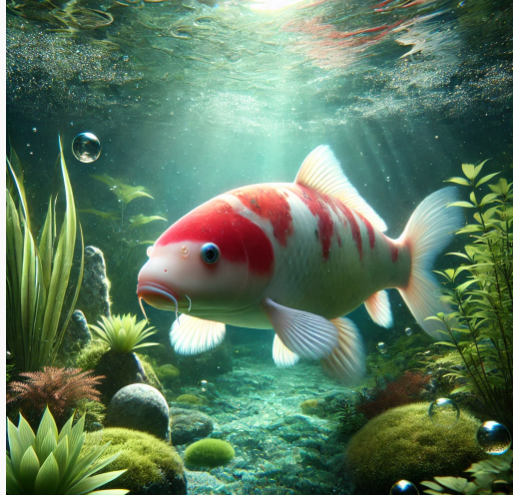Koi fish are beautiful, hardy, and long-living, but like any other living creature, they are susceptible to diseases. A well-maintained pond and proactive care can prevent many common koi fish diseases.
Understanding what causes these illnesses and how to prevent them can save your koi from stress, suffering, and even death. In this guide, we’ll discuss the most common koi fish diseases, how to spot early warning signs, and the best practices to keep your koi healthy.
1. Understanding the Common Causes of Koi Diseases
Koi fish diseases often arise from poor water quality, stress, parasites, bacteria, and fungi. Here are the main culprits:
✔ Poor Water Quality – Dirty or unbalanced water weakens koi’s immune systems.
✔ Overcrowding – Too many koi in one pond can cause stress and poor oxygen levels.
✔ Parasites and Bacteria – Harmful organisms like Ich and flukes can attack weakened koi.
✔ Sudden Temperature Changes – Extreme water temperature shifts can lead to stress and disease outbreaks.
✔ New Infected Fish – Adding koi to your pond without quarantining them first may introduce diseases.
2. Common Koi Fish Diseases & How to Prevent Them
Here are the most frequent health issues koi owners face and how to protect your fish from them.
🐟 1. Ich (White Spot Disease)
- Symptoms: Small white spots on the skin, flashing (rubbing against surfaces), rapid gill movement.
- Cause: A parasitic infection due to stress, sudden temperature changes, or poor water quality.
- Prevention:
✔ Keep water temperature consistent.
✔ Avoid sudden temperature fluctuations.
✔ Quarantine new fish before introducing them to the pond.
🐟 2. Koi Fin Rot
- Symptoms: Frayed, discolored, or rotting fins.
- Cause: Bacterial infection, often due to poor water conditions or injuries.
- Prevention:
✔ Maintain high water quality by testing and cleaning regularly.
✔ Remove sharp objects in the pond that could damage fins.
✔ Treat wounds immediately to prevent bacterial infections.
🐟 3. Koi Ulcers (Bacterial Infections)
- Symptoms: Red sores, open wounds, inflamed scales.
- Cause: Caused by Aeromonas bacteria, which thrive in dirty water.
- Prevention:
✔ Ensure good filtration and perform regular water changes.
✔ Feed koi with high-quality food to boost immunity.
✔ Avoid handling koi unnecessarily, as it may cause stress and injuries.
🐟 4. Koi Dropsy (Pinecone Disease)
- Symptoms: Swollen body, raised scales that look like a pinecone, loss of balance.
- Cause: Often linked to kidney failure caused by bacterial infection or internal parasites.
- Prevention:
✔ Keep water clean and well-oxygenated.
✔ Isolate infected fish to prevent disease spread.
✔ Avoid overfeeding, as uneaten food rots and pollutes the water.
🐟 5. Koi Fish Lice (Argulus)
- Symptoms: Visible green or brown lice on the body, koi scratching against objects.
- Cause: Introduced by new fish or pond plants that carry parasites.
- Prevention:
✔ Always quarantine new fish and plants before adding them to the pond.
✔ Use pond treatments to kill parasites before they spread.
🐟 6. Swim Bladder Disorder
- Symptoms: Koi struggling to stay upright, floating to the surface or sinking.
- Cause: Caused by poor diet, constipation, or bacterial infection.
- Prevention:
✔ Feed a balanced diet and include fiber-rich foods like peas.
✔ Avoid overfeeding and low-quality food that lacks essential nutrients.
3. Essential Tips to Prevent Koi Fish Diseases
✅ Maintain Optimal Water Quality
- Test pH, ammonia, nitrites, and nitrates regularly.
- Keep pH between 7.0 – 8.5 and ammonia levels at zero.
- Install a quality filtration system and clean it regularly.
✅ Quarantine New Fish
- Always quarantine new koi for 2-3 weeks before adding them to the main pond.
- Observe them for any disease symptoms before release.
✅ Provide a Healthy Diet
- Feed high-quality koi food rich in proteins, vitamins, and fiber.
- Avoid cheap, filler-based food that lacks proper nutrition.
- Supplement their diet with vegetables, fruits, and occasional protein snacks.
✅ Prevent Overcrowding
- Ensure at least 250 gallons of water per koi.
- Too many koi in a small pond increases stress, disease risk, and poor water quality.
✅ Keep Water Well-Oxygenated
- Install a koi pond aerator or a waterfall feature to maintain oxygen levels.
- Monitor oxygen levels especially in hot weather, as warmer water holds less oxygen.
✅ Check for Early Signs of Disease
- Observe koi daily for changes in behavior, appetite, or physical appearance.
- Isolate and treat sick fish immediately to prevent outbreaks.
4. Best Products to Keep Koi Healthy
| Product | Purpose | Why You Need It |
| Koi Pond Test Kit | Checks pH, ammonia, and nitrites | Helps prevent poor water conditions |
| High-Quality Koi Food | Boosts immune system | Prevents nutritional deficiencies |
| UV Sterilizer | Kills harmful bacteria and parasites | Keeps water clean and clear |
| Pond Aerator | Improves oxygen levels | Reduces stress and disease risk |
| Quarantine Tank | Isolates sick fish | Prevents spreading diseases |
5. What to Do If Your Koi Gets Sick?
If you notice signs of illness, follow these steps to treat your koi effectively:
✔ Move sick fish to a quarantine tank to prevent the disease from spreading.
✔ Check water parameters—if levels are off, correct them immediately.
✔ Use disease-specific treatments (e.g., anti-parasitic for Ich, antibiotics for ulcers).
✔ Keep the water temperature stable to avoid further stress.
✔ Consult a koi specialist or veterinarian if symptoms persist.
Final Thoughts: Keep Your Koi Healthy and Thriving
Preventing koi diseases is easier than treating them. By maintaining clean water, feeding a proper diet, and reducing stress, your koi will stay healthy and vibrant for years to come.
🐟💙 A happy koi is a healthy koi! What are your best tips for preventing koi diseases? Share your thoughts in the comments! ⬇️




